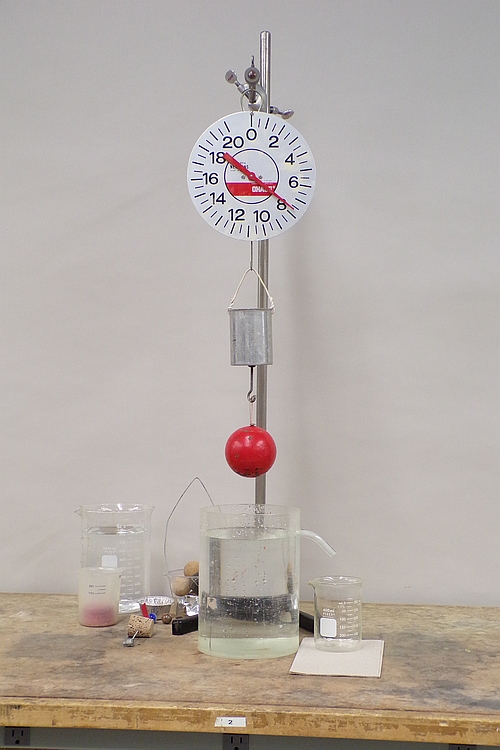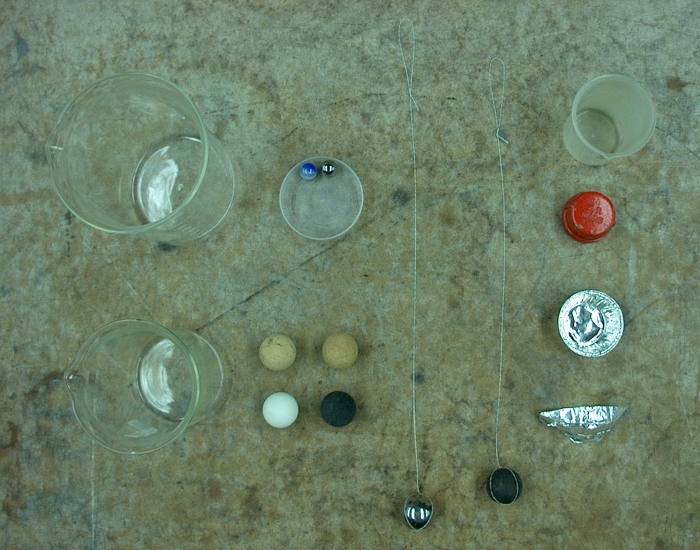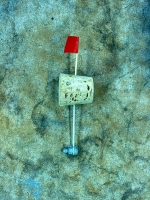
This demonstration illustrates Archimedes’ principle, which states that a body wholly or partly immersed in a fluid is buoyed by a force equal to the weight of the fluid it displaces. One can arrive at this principle by imagining some arbitrary volume sitting in the middle of a vessel filled with fluid. This volume of fluid experiences forces exerted by the surrounding fluid over its entire surface, such that it remains static. We can therefore conclude that the sum of all the forces over the volume’s surface yields a resultant force that exactly counters the gravitational force acting on the volume, i.e., its weight. This force is called the buoyant force, and when acting on an immersed object it is called the object’s buoyancy.
In the setup shown in the photograph above, a cup that has a sphere hanging from it is suspended from a spring scale. The weight of the sphere and cup together is approximately 7.75 N, as the scale reads in the photograph. Before you show the demonstration, the vessel beneath the sphere should be filled just until water exits through the spout, and then an empty beaker placed under it when the flow has stopped. As you immerse the sphere, the displaced water flows through the spout into the beaker below. The volume of the sphere is approximately 324 ml, so when the sphere is entirely submerged, the force registered by the scale decreases by about 3.2 N (to about 4.5 N). If you partially immerse the sphere, the reading on the scale decreases by the weight of the volume of water displaced by the part of the sphere that is submerged. When you have submerged the entire sphere, you can pour the water from the beaker into the cup hanging from the scale. The weight of this water will exactly counter the buoyancy of the sphere, and the reading on the scale will return to about 7.75 N. You can also show, of course, that once the entire sphere is submerged, no matter how deeply it is submerged, the buoyancy remains constant. (You will, however, need to leave enough room for the sphere to descend slightly when you pour the water into the cup.)
Since the mass of a material equals the product of its density and its volume, if ρfluid is the density of the fluid displaced by an object submerged in it, and V is the volume of the fluid displaced, the magnitude of the buoyant force, B, on the object is
B = ρfluidVg
Similarly, the weight of the submerged object (in air), W, is
W = ρVg
where ρ is the density of the object. If ρ < ρfluid, then B > W, and when it is released, the object floats to the level at which the weight of the fluid it displaces equals its weight. If ρ > ρfluid, then B < W, and when it is released, the object sinks. If the fluid is water, we can can denote the density as ρw, which we may take as 1 g/cm3, or in SI units, 1,000 kg/m3. (At 25 °C the density of water is 0.997 g/ml.) The ratio of the density of a material relative to that of water, ρ/ρw, is the relative density or specific gravity of the material. If B > W, then as noted above, the object floats until B = W. At this point,
ρfluidVfluid = ρV
and the fraction of the object submerged is
Vfluid/V = ρ/ρfluid
Archimedes’ insight regarding buoyancy came when King Hiero approached him with a problem. Hiero had given a goldsmith a specific amount of gold, and asked him to make it into a gold wreath. When he received the wreath, its weight matched that of the original amount of gold, but Hiero suspected that the goldsmith had substituted another metal for some of the gold. He did not know how to determine this without destroying the wreath, so he asked Archimedes for advice. As the story goes, while Archimedes was considering this problem, he got into his bathtub. When he entered the tub, he noticed that the water level rose, and realized that as he submerged himself in the water, he displaced a volume of water equal to the volume of the portion of his body that was submerged. He then realized that he could determine the density of the crown by weighing it while it was submerged in water and then comparing that weight to its weight in air, and thus solve King Hiero’s problem. Supposedly, he was so greatly excited by this thought that he leaped from the tub and ran naked through the streets of Syracuse shouting, “Eureka! Eureka!” (“I’ve found it! I’ve found it!”).
We can see from the equations above that the specific gravity of an object is the ratio of the weight of the object in air to the weight of an equal volume of water. Archimedes realized that the weight of the volume of water displaced by an object equals the buoyant force on the object, and thus the difference between its weight in air and its weight when it is submerged. That is,
Specific gravity = W/B (= W/(W - Ws), where Ws is the weight of the submerged object)
He reasoned that he could weigh the wreath in air, then weigh it when it was submerged in water, calculate its specific gravity from the two weights that he obtained, and then compare this to the specific gravity that he measured for gold. (Alternatively, he could use the specific gravity of gold and the weight of the wreath in air to calculate how much the wreath should weigh when it is submerged, and then compare the measured weight of the submerged wreath to his calculated weight.)
From the above we can find an expression for the weight of a submerged object in terms of its weight in air, W, its density and the density of the fluid in which it is submerged:
Ws = W - B = ρVg - ρfluidVg = ρVg [1 - (ρfluid/ρ)], or
Ws = W[1 - (ρfluid/ρ)]
Archimedes’ principle is what keeps ships afloat. The greater the load a ship carries, the greater the depth to which the ship’s hull sinks into the water. Out of concern for the safety of ships and their crews, various countries throughout history have developed the idea of a load line, a mark indicating the maximum safe loading of a vessel. You can find information about this from the International Maritime Organization here, and from the U.S. Coast Guard here. During the 1860s, a British Parliamentarian named Samuel Plimsoll pressed for legislation regarding the use of load lines, and the load line, or international load line, which all ships must have, is called a Plimsoll line in his honor.
Archimedes’ principle is illustrated by the impressive engineering feat of the Magdeburg water bridge, which connects the Elbe-Havel Canal and the Mittellandkanal to carry ships (yes, ships!) over the Elbe river (yes, over the Elbe!). You can read about this bridge and see photographs of it here, here and, with photographs of two other water bridges, here. Where Archimedes’ principle enters is in the question of how much weight the engineers must design the bridge to support. Since the ships traveling across the bridge must displace their own weight in water, the only weight the engineers needed to consider was that of the water contained by the bridge. The displaced water merely goes off the ends of the bridge, as the water level is kept constant by means of locks in the canals.
Chuck Reese and I have assembled a group of accessories, shown in the photograph below, to go with this demonstration.
With the various balls, you can illustrate the concepts of volume, density and displacement in various ways. All of the large balls have roughly the same volume, but the steel ball and wooden balls (black) sink, and the cork balls and the ping-pong ball float. The small steel ball and marble have approximately the same volume. You can also use a fluid that has a different density from that of water.
You can place the red pipe cap, which has a mass of 235.8 g, into the plastic beaker shown above it, which has a mass of 39.9 g. When you then set the beaker in water, it displaces approximately 276 ml of water, which you can show by noting that it sinks to a level corresponding to roughly 25 ml greater than the top line on its scale, which marks 250 ml.
With the aluminum foil, you can make a boat, which floats. When you completely flatten the boat into a small square, it sinks. You can make the point that when the foil is shaped like a boat, it can displace its weight in water and still be above the surface, but when the foil is folded up, it displaces much less than its weight in water and sinks.
You can also use the foil cup as a boat, but it is not stable with any of the masses shown. The foil boat is stable with the marble in it, but the steel ball is heavier than the volume the boat can displace before it sinks. Of course, a sufficiently large foil boat, or one with the proper shape, would support the steel ball without sinking.
At Prof. Harry Nelson’s request, the accessory in the photograph below has also been added. It is a cork with a mass suspended from it, and a flag mounted opposite the mass. The purpose of this device is to show that, if possible, an object floats in such an orientation as to minimize the height of its center of mass. If the mass hanging from the cork is displaced to either side, gravity exerts a torque about the float to put the mass back underneath the cork. Thus, the cork always floats with the mass directly beneath it, and the flag directly above.
References:
1) Tipler, Paul A. Physics For Scientists and Engineers, Third Edition, Volume 1 (New York: Worth Publishers, 1990), pp.340-3.
2) Halliday, David and Resnick, Robert. Physics, Part One, Third Edition (New York: John Wiley and Sons, 1977), pp. 376-7.
3) Weast, Robert C., Ed. Handbook of Chemistry and Physics, 51st Edition (Cleveland, Ohio: The Chemical Rubber Co., 1970), p. F-5.
4) https://www.newworldencyclopedia.org/entry/Archimedes#Archimedes.27_Principle.
5) https://en.wikipedia.org/wiki/Archimedes and https://en.wikipedia.org/wiki/Archimedes#Archimedes'_principle, therein.

